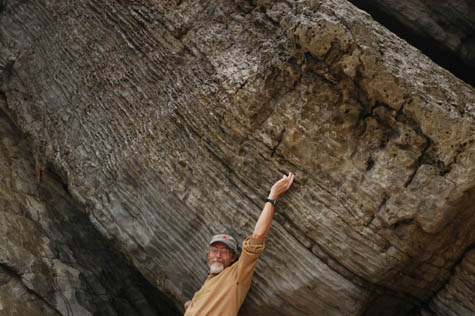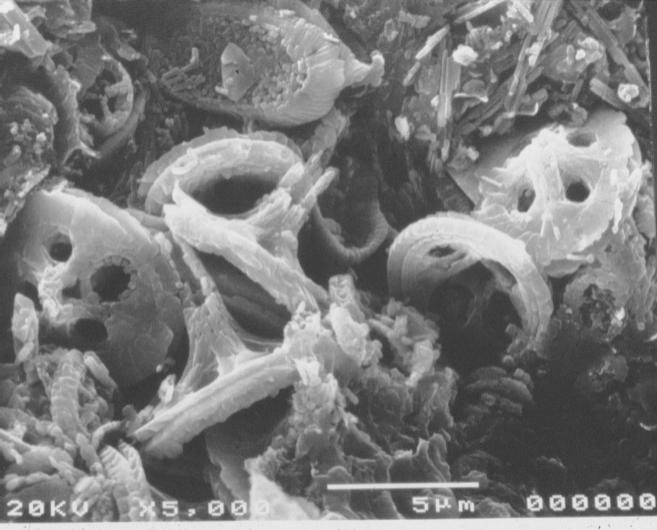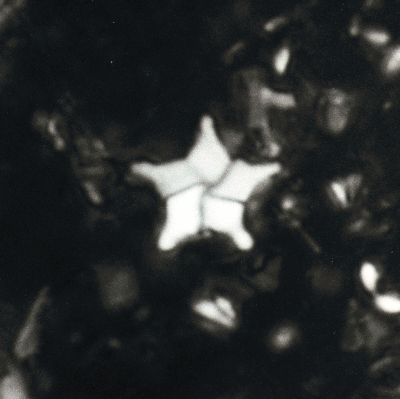|
| Huber, B.T., M. R. Petrizzo, D. K. Watkins, S. J. Haynes, and K. G. MacLeod, 2017, Correlation of Turonian continental margin and deep-sea sequences in the subtropical Indian Ocean sediments by integrated planktonic foraminiferal and calcareous nannofossil biostratigraphy, Newsletters on Stratigraphy, 50, 141-185. |
| Haynes, S.J., K.G. MacLeod, B.T. Huber, S. Warny, A.J. Kaufman, R.D. Pancost, A.J. Berrocoso, M.R. Petrizzo, D.K. Watkins, I. Zhelezinskaia, 2017, Southeastern Tanzania depositional environments, marine and terrestrial links, and exceptional microfossil preservation in the warm Turonian. Geological Society of America Bulletin. doi: 10.1130/B31432.1. |
| Kita, Z.A., Watkins, D.K., Sageman, B.B., 2016, High-resolution calcareous nannofossil biostratigraphy of the Santonian/Campanian Stage boundary, Western Interior Basin, USA, Cretaceous Research, doi: 10.1016/j.cretres.2016.08.015. |
| Kita, Z.A., D.K. Watkins, and J.A. Bergen, 2016, A new calcareous nannofossil species of the genus Helicolithus from the Santonian and its biostratigraphic significance in the Cretaceous Western Interior Seaway, Journal of Nannoplankton Research, 36, 77-82. |
| Brace, B.J., and D.K. Watkins, 2015, Global abundance decline in the productivity indicator Biscutum during the Cretaceous. Journal of Nannoplankton Research, 30, 129-140. |
| Ando, A., B.T. Huber, K.G. MacLeod, and D.K. Watkins, 2015, Early Cenomanian “hot greenhouse” revealed by oxygen isotope record of exceptionally well-preserved foraminifera from Tanzania. Paleoceanography, 30, 1556-1572. doi:10.1002/2015PA002854 |
| Brace, B.J. and D.K. Watkins, 2014, Evolution of the Calcareous Nannofossil Genus Biscutum in the middle to Upper Cretaceous North American mid-latitudes, Micropaleontology, 60, 445-463. |
| Corbett, M.J., and D.K. Watkins, 2014, Cenomanian through basal Coniacian Calcareous Nannofossil biostratigraphy of the Mancos Shale reference section, Mesa Verde National Park, CO, Stratigraphy, 11, 97-108. |
| Kell, J.P. and David K. Watkins, 2014, Data report: calcareous nannofossil biostratigraphy of Expedition 330, Louisville Seamount Trail, Sites U1372–U1377, Koppers, A.A.P., Yamazaki, T., Geldmacher, J., and the Expedition 330 Scientists, Proceedings of the Integrated Ocean Drilling Program, Volume 330. doi:10.2204/iodp.proc.330.201.2014 |
| Lowery, C.M., M.J. Corbett, R.M. Leckie, D.K.Watkins, T.S. Staerker, A.D. Donovan, A. Miceli-Romero, and A. Pramudito, 2014, Foraminiferal and Nannofossil paleoecology and paleoceanography of the Cenomanian-Turonian Eagle Ford Shale of southern Texas, Palaeogeography, Palaeoclimatology, Palaeoecology. doi.org/10.1016/j.palaeo.2014.07.025 |
| Corbett, M.J., D.K. Watkins, and J.J. Pospichal, 2014, Quantitative Analysis of Calcareous Nannofossil Bioevents of the Late Cretaceous (Late Cenomanian-Coniacian) Western Interior Seaway and their Reliability in Established Zonation Schemes, Marine Micropaleontology, doi:10.1016/j.marmicro.2014.04.002. |
| Corbett, M.J., and D.K. Watkins, 2014, Transitional forms in the Eprolithus-Lithastrinus lineage: a taxonomic revision of Turonian through Santonian species, Micropaleontology, 60. |
| Corbett, Matthew J., Watkins, David K., 2013, Calcareous Nannofossil Paleoecology of the mid-Cretaceous Western Interior Seaway and Evidence of Oligotrophic Surface Waters during OAE2, Palaeogeography, Palaeoclimatology, Palaeoecology(2013), doi: 10.1016/j.palaeo.2013.10.007 |
| Self-Trail, J.M., D.S. Powars, D.K. Watkins, G. Wandless, 2012, Calcareous Nannofossil Assemblage Changes Across the Paleocene-Eocene Thermal Maximum: Evidence from a Shelf Setting, Marine Micropaleontology, 92–93, 61–80. |
| Shamrock, J.L., D.K. Watkins, and K.W. Johnston, Eocene bio-geochronology of ODP Leg 122 Hole 762C, Exmouth Plateau (northwest Australian Shelf), Stratigraphy 9, 55-76. |
| Shamrock,. J.L., and D.K. Watkins, 2012, Eocene calcareous nannofossil biostratigraphy and community structure from Exmouth Exmouth Plateau, Eastern Indian Ocean (ODP Hole 762C), Stratigraphy, 9, 1-54. |
| Blair, S.A,, and D.K. Watkins, 2009, High-resolution calcareous nannofossil biostratigraphy for the Coniacian/Santonian Stage boundary, Western Interior Basin, Cretaceous Research, 30, 367-384, doi:10.1016/j.cretres.2008.07.016. |
| Shamrock, J.L., and D.K. Watkins, 2009, Evolution of the Cretaceous calcareous nannofossil genus Eiffellithus and its biostratigraphic significance, Cretaceous Research, 30, 1083-1102, doi:10.1016/j.cretres.2009.03.009 |
| Browning, E. L., and D. K. Watkins (2008), Elevated primary productivity of calcareous nannoplankton associated with ocean anoxic event 1b during the Aptian/Albian transition (Early Cretaceous), Paleoceanography, 23, PA2213, doi:10.1029/2007PA001413. |
| Weber, R.D., and D.K. Watkins, 2007, Evidence from the Crow Creek Member (Pierre Shale) for an impact-induced resuspension event in the Late Cretaceous Western Interior Seaway, Geology, 35, 119-1122. |
| Watkins, D.K., 2007, Quantitative analysis of the calcareous nannofossil assemblages from CIROS-1, Victoria Land Basin, Antarctica, Journal of Nannoplankton Research, 29, 130-137. |
| Watkins, D.K., M.J. Cooper, and P.A. Wilson, 2005, Calcareous nannoplankton response to late Albian Oceanic Anoxic Event 1d in the Western North Atlantic, Paleoceanography, 20, 14 p., doi:10.1029/2004PA001097. |
| Watkins, David K.and J.M. Self-Trail, 2005, Calcareous nannofossil evidence for the existence of the Gulf Stream during the late Maastrichtian, Paleoceanography, 20, 9 p. doi 10.1029/2004PA001121. |
| Holmes, M.A., D.K. Watkins, and R.D. Norris, 2004, Paleocene cyclic sedimentation in the western North Atlantic, ODP Site 1051, Marine Geology, 209, 31-43. |
| Watkins, D.K., and J.A. Bergen, 2003, Late Albian adaptive radiation in the calcareous nannofossil genus Eiffellithus, Micropaleontology, 49, 231-252. |
|







